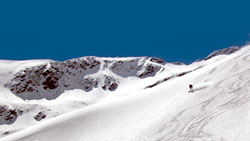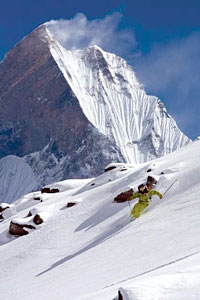 DOUGH JOHNSON |
Until recently, Nepal's mountains were mainly the province of mountaineers. Today, heli-skiing is here, allowing enthusiasts to ski down slopes that could previously only be climbed.
 RICHARD RAGAN VIRGIN SNOW: A MI-17 helicopter drops off skiers high up on the Annapurna sanctuary. Skiers then snowboard down a gentle slope. |
In addition to being an outstanding skier you've got to be a topnotch winter mountaineer. Miura's descent, as pioneering as it was, took place in spring and only covered approximately 2,500 metres down the steep ice of the Lhotse face.
Previously, skiing in Nepal meant two grueling months on a mountaineering expedition getting pounded by bad weather and altitude sickness. Today, the use of helicopters has changed the mix. Skiers and snowboarders can now ascend to 5,800 metres, and with a little climbing, go even higher. Nepal's snowline doesn't start until 3,500 metres, which is already higher than the summit of any ski resort in other parts of the world.
Admittedly, stepping out of the helicopter at 5,200 metres on the first run can leave a person panting, but soon the body acclimatises. Using the mountaineering principle of climbing high and sleeping low, skiers ride high and rest low, and this formula seems to work.
 SEB LEON A steeper section amidst a backdrop of Machapuchre from the north. |
The heli-skiing season runs from late February through early April and trips so have far been taken to the Humla/Dolpa area, the Annapurnas and the Khumbu. This year, lack of snow and increasingly expensive helicopter rates means nobody will be skiing or snowboarding in Nepal during the 2009 season. For the sport to really take hold, flying costs have to become competitive. Local helicopter operators are charging three to four times more per flying hour than their competitors in other counties thereby pricing themselves out of the market.
Nepal isn't a place for people learning to ski or snowboard. These are formidable mountains where avalanche danger, fast changing weather patterns and difficult terrain, are the norm. But if you're experienced and have a sense of adventure, there is no better place on earth to take some turns.
 |
 |
 |


